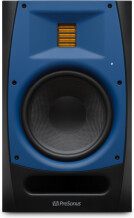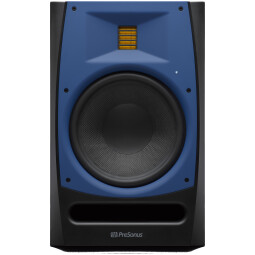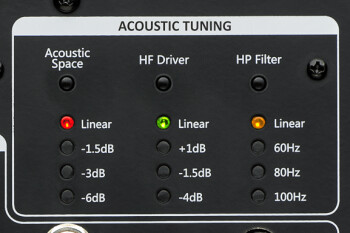PreSonus recently added to its growing line of studio monitors with its new R-Series, active near-field monitors that feature AMT tweeters, and come in two sizes, the R80 (8” woofer) and the R65 (6.5” woofer). We got our hands on a pair of R80s for this review.
Looking them over
The first thing I noticed when I got the R80s out of their boxes was that they’re nice and compact compared to a lot of 8” monitors. The cabinets measure 9.5” x 15” x 12”, and weight a shade under 20 lbs. each.
The enclosures are ported on the bottom of the front panel, and a nice-looking blue plate encloses both the 8” kevlar woofer and 6.8” AMT tweeter. A front panel power status light is included on each speaker.
For those unfamiliar, AMT stands for Air Motion Transformer, and is a different technology than the dome-type tweeters that you find in most studio monitors. It is somewhat reminiscent of a ribbon tweeter, but is a different shape and made of different material. AMT tweeters feature very fast response and low distortion, and according to PreSonus are designed to provide “air and [a] sense of space not possible with traditional dome tweeters.”
The frequency response of the R80 is listed as 40 Hz to 22 kHz.
Back in black
The back of the monitors offer quite a few options. First, you can choose from three input formats: balanced XLR, balanced TRS 1/4” or unbalanced RCA. I used the XLR inputs, but it’s handy to have such a wide choice. A level knob is included that lets you adjust the loudness from Min to Max settings. I was glad to see that it has a center detent. That way, you have three options; Max, Min, and the center, where you can be sure both speakers’ levels are evenly set. I’d actually like to see a couple of more detents in the range, to give you more level choices that you know are balanced between the speakers.
The back panel offers three adjustable EQ options for tailoring the monitors to your room. The first, Acoustic Space, is designed for reducing bass boost that can occur when monitors are placed close to walls or corners. When engaged, it cuts frequencies from 250 Hz and below by your choice of –1.5 dB, –3 dB, or –6 dB.
Next to it is the HF Driver circuit. It allows you to tailor the response of the high-frequency driver. It affects the signal from 2 kHz and higher. You can adjust it to boost by +1 dB or cut by –1.5 dB or –4 dB.
Finally, a high-pass filter is included so that you can adjust the low end to the crossover frequency of a subwoofer if you add one to the system. Each monitor is bi-amplified, with a 100W RMS going to the woofer and 50W RMS to the AMT tweeter.
Turn those suckers on!
The R80s come with a set of four small rubber pads to be placed on the bottom corners of the cabinets to help with decoupling them. I tested them with just those pads on my wooden speaker stands, and also with Primacoustic Recoil Stabilizers underneath them. Both sounded good, although the image was (not surprisingly) a bit more focused with the Stablizers between the monitors and the stands.
I also tried them out in two different positions: About 4 feet diagonally from each ear, and about 2.5 feet diagonally from each ear. They sound was particular impressive at the closer position, where I was hearing them with less impact from the room.
The speakers provided good low-end detail (they go down to 40 Hz) without being boomy. I could hear the lower parts of the kick drum and bass. Upright bass was nicely reproduced as well. For the kind of music I generally mix, acoustic, bluegrass, rock, blues and country, I wouldn’t feel the need to add a subwoofer. If I were mixing electronic dance music or hip hop, it might be a different story, as there certainly is more territory below 40 Hz that can impact a dance mix, in particular.
One of the things that really impressed me was how smooth the R80’s response was. The transitions between low, mid, and high frequencies were seamless, and everything sounded very natural. The high-end was clear and detailed without being harsh. I used the R80s in mix sessions and didn’t find them in the slightest bit fatiguing, thanks to the AMT tweeters.
The imaging was good, as well. Even with the speakers only about five feet apart, I still got a nice wide stereo spread.
Conclusion
I have grown quite fond of the R80s ($499 each) in my four or so weeks of using them. They’re comfortable to listen to, and they have a smooth sound and an even frequency response. The R80s are the first speakers I’ve used with AMT tweeters, and I’m very impressed. What’s more, the generous input and EQ options, and the HP filter for adding a subwoofer, increase the monitors’ utility. While they’re certainly not cheap, they’re reasonably priced for the quality you get. Good job PreSonus.






